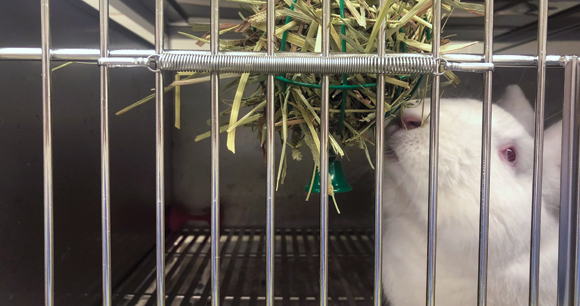by Kathleen Coda, DVM, postdoctoral clinical veterinarian at the University of Illinois at Chicago Biologic Resources Laboratory
One of the goals of environmental enrichment is to encourage species-typical behaviors while discouraging abnormal behaviors. Assessing the effectiveness of various enrichment strategies can be a challenging endeavor, particularly for prey species who may exhibit freezing responses in the presence of people. The goal of our study, which was funded by an AWI Refinement Grant, was to determine if we could use various environmental enrichment strategies to promote species-specific behaviors, decrease potentially abnormal behaviors, and improve the overall welfare of rabbits in laboratories.

We began by looking at cage size as a form of enrichment. We video recorded rabbits in three cages that varied in size: a standard housing cage (25 x 29.5 x 16 inches), a medium-sized cage (28 x 45 x 27 inches), and a large run (65 x 70 x 96 inches). After reviewing the videos, we constructed an ethogram of laboratory rabbit behaviors. We then used that ethogram to quantify behaviors seen in the rabbits in the various cage sizes.
We found that rabbits housed in large runs spent an average of 71.8 percent of the time performing active, exploratory behaviors, 24.2 percent resting, and only 4 percent of time performing self-directed grooming behaviors. By comparison, rabbits housed in the standard cages spent 30.7 percent of the time engaged in active behaviors, 34.8 percent resting, and 34.5 percent grooming. The differences in time spent performing active behaviors and time spent performing self-directed grooming behaviors were statistically significant (p<0.05). This led us to surmise that housing rabbits in larger cages has a positive impact on their welfare, allowing them more space and opportunity to perform active, species-typical behaviors while reducing potentially stereotypic self-directed grooming behavior.
In facilities where rabbits aren’t currently housed in large runs, the standard cage may nonetheless be much improved by adding relevant items into the cage. Therefore, we decided to explore if the provision of enrichment devices while being housed in the standard size cage could promote the increased expression of active behaviors similar to what was seen with rabbits in the large runs. We selected three devices: a hanging toy, a destructible device, and a dig bin. The provision of all three enrichment devices led to more time spent performing active, exploratory behaviors (64.9, 77.1, and 70.0 percent of time, respectively) than what was seen in control rabbits with no enrichment device (37.6 percent of time). The enrichment devices also reduced the time spent performing grooming behavior (hanging toy 3.3 percent, destructible 2.6 percent, and dig bin 6.7 percent of time) compared to control rabbits with no enrichment device (24.4 percent of time). These changes were again statistically significant (p<0.05).
Overall, the provision of large runs or the addition of enrichment devices into standard cages encouraged a broad spectrum of active, species-typical rabbit behaviors, while simultaneously reducing potentially stereotypic self-directed grooming behavior. We have since added these enrichment devices to our care and use program and find them to be an easy, cost-effective way to improve welfare.